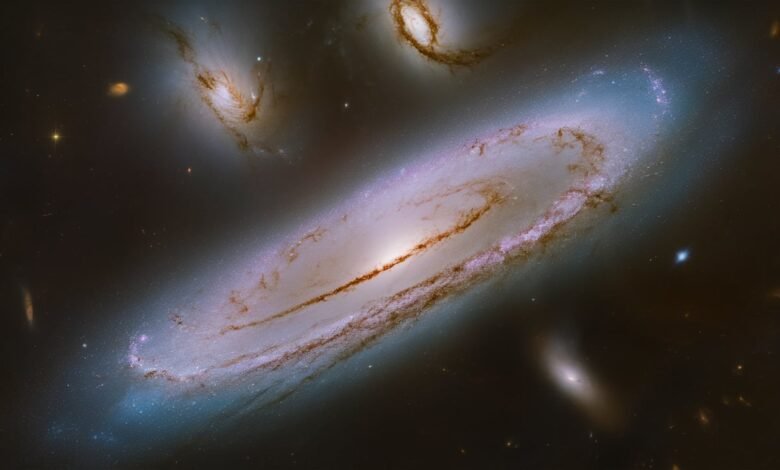Sdss J123132.37 013814.1: A Cosmic Journey to a Distant Quasar

Imagine looking up at the night sky, a canvas of twinkling stars and distant galaxies. Among these celestial wonders lies an object so powerful and far away that it challenges our understanding of the universe: SDSS J123132.37+013814.1. This isn’t just a random string of numbers and letters it’s the name of a fascinating quasar, a glowing beacon from the early universe. In this article, we’ll take a friendly, easy-to-read journey to explore what makes this quasar special, why it matters, and how it helps us piece together the story of the cosmos. Whether you’re a space enthusiast or just curious, let’s dive into the stars together!
What Is SDSS J123132.37+013814.1?
Let’s start with the basics. SDSS J123132.37+013814.1 is a quasar, a type of extremely bright object found in the distant reaches of space. The name might sound complicated, but it’s like a cosmic address. “SDSS” stands for the Sloan Digital Sky Survey, a massive project that maps the sky using a powerful telescope in New Mexico. The numbers “J123132.37+013814.1” tell astronomers exactly where to find this quasar in the sky, based on its coordinates (right ascension and declination, if you want to get technical).
Quasars like this one are not your average stars. They’re powered by supermassive black holes at the centers of galaxies, gobbling up gas and dust. As this material spirals into the black hole, it heats up and releases tremendous amounts of energy, making quasars some of the brightest objects in the universe. Think of them as cosmic lighthouses, shining across billions of light-years!
This particular quasar is about 1.4 billion light-years away from Earth. That means the light we see from it today started its journey when the universe was much younger about 1.4 billion years ago. It’s like receiving a postcard from the distant past, giving us clues about what the universe was like back then.
The Sloan Digital Sky Survey: A Window to the Stars
To understand SDSS J123132.37+013814.1, we need to give a shout-out to the Sloan Digital Sky Survey. This project is like a giant photo album of the universe, capturing images and data from millions of stars, galaxies, and quasars. Using a 2.5-meter telescope at Apache Point Observatory, astronomers collect light from faraway objects and analyze it to learn about their properties.
The survey has been a game-changer for astronomy. It’s mapped a huge chunk of the sky, helping scientists discover objects like our quasar. By studying the light from SDSS J123132.37+013814.1, astronomers can figure out its distance, composition, and even the size of the black hole at its heart. It’s like solving a cosmic puzzle, one piece of light at a time.
Why Quasars Are So Special
Quasars are more than just bright lights in the sky they’re key to understanding the universe’s history. Here’s why SDSS J123132.37+013814.1 and its quasar cousins are so exciting:
- They’re Time Machines: Because this quasar is 1.4 billion light-years away, we’re seeing it as it was billions of years ago. It’s a snapshot of the early universe when galaxies were forming and black holes were growing.
- Powered by Black Holes: At the heart of SDSS J123132.37+013814.1 is a supermassive black hole, likely billions of times more massive than our Sun. The energy it releases as it consumes material outshines entire galaxies.
- Clues to Galaxy Evolution: Quasars live in galaxies, and studying them helps us understand how galaxies form and change over time. The black hole’s activity can influence star formation and the galaxy’s structure.
- Bright Beacons: Quasars are so luminous that we can see them from incredible distances. They help astronomers map the universe and study its expansion.
This quasar is classified as a “Type 1” quasar, which means it has a bright, star-like center and shows broad emission lines in its spectrum (more on that later). These features make it a perfect candidate for studying the wild environment around a supermassive black hole.
Decoding the Light: What the Spectrum Tells Us
One of the coolest things about SDSS J123132.37+013814.1 is how astronomers use its light to learn about it. When light from the quasar is split into a spectrum like a rainbow it reveals a wealth of information. Here’s what we know:
- Redshift: The quasar has a redshift of about 1.13. Redshift happens because the universe is expanding, stretching the light as it travels to us. This redshift tells us the quasar is 1.4 billion light-years away.
- Emission Lines: The spectrum shows bright lines, like the Lyman-alpha line, caused by energized gas in the quasar’s accretion disk (the swirling material around the black hole). These lines help estimate the black hole’s mass and how fast it’s feeding.
- Absorption Lines: There are also dark lines in the spectrum, caused by gas in the quasar’s galaxy or along the line of sight. These lines act like fingerprints, revealing what the gas is made of.
By studying these features, astronomers can estimate that the black hole in SDSS J123132.37+013814.1 is massive—potentially around a billion solar masses. That’s a billion Suns squished into a region smaller than our solar system!
A Peek into the Early Universe
Why does SDSS J123132.37+013814.1 matter? It’s a window into the early universe, a time when supermassive black holes were growing rapidly. Quasars like this one were more common back then, lighting up the cosmos as black holes feasted on gas and dust. By studying this quasar, we learn about:
- Black Hole Growth: How did supermassive black holes get so big? Quasars show us the feeding frenzy that fueled their growth.
- Galaxy Formation: The quasar’s host galaxy likely formed alongside the black hole. Understanding their relationship helps us figure out how galaxies like our Milky Way came to be.
- Cosmic Evolution: Quasars trace the universe’s expansion and the distribution of matter, giving us clues about dark energy and the universe’s structure.
This quasar is part of a bigger story. By comparing it to others found by the Sloan Digital Sky Survey, astronomers see patterns like how quasars with higher redshifts (farther away) tend to be brighter, hinting at more massive black holes in the early universe.
The Science Behind the Shine
Let’s get a bit nerdy (in a fun way!) and talk about what makes SDSS J123132.37+013814.1 shine so brightly. The secret lies in the accretion disk, a swirling ring of gas and dust spiraling into the black hole. As this material gets pulled in, it heats up to millions of degrees, releasing energy across the electromagnetic spectrum from radio waves to X-rays.
This energy is what makes quasars outshine their host galaxies. SDSS J123132.37+013814.1 is so bright that it can be detected even from billions of light-years away. Astronomers use techniques like the virial theorem and reverberation mapping to estimate the black hole’s mass. These methods measure how fast gas is moving around the black hole and how long it takes for light to travel through the accretion disk.
Challenges and Mysteries
Studying SDSS J123132.37+013814.1 isn’t all smooth sailing. Quasars are complex, and there are still plenty of questions:
- How Did the Black Hole Get So Big? Supermassive black holes in quasars like this one were already huge when the universe was young. Did they grow by merging with other black holes or by gobbling up material quickly?
- What’s the Host Galaxy Like? The quasar’s brightness makes it hard to see its host galaxy. New telescopes, like the James Webb Space Telescope, might help us peek at it.
- Why Are Quasars So Rare Today? Quasars were common in the early universe but are rare now. What changed to make them less active?
These mysteries keep astronomers up at night (and their telescopes busy!).
The Future of Quasar Research
The story of SDSS J123132.37+013814.1 is far from over. New technologies and surveys are pushing our understanding further. For example:
- Advanced Telescopes: The Vera C. Rubin Observatory and the Euclid space mission will find more quasars and study them in greater detail.
- Machine Learning: Artificial intelligence is helping astronomers sift through massive datasets, spotting patterns in quasar spectra.
- Multi-Wavelength Observations: Combining data from radio, infrared, and X-ray telescopes gives a fuller picture of quasars and their environments.
These advancements will help us learn more about SDSS J123132.37+013814.1 and its place in the cosmic puzzle.
Why Should You Care?
You might be wondering, “Why does a quasar 1.4 billion light-years away matter to me?” Fair question! Here’s why:
- It’s Our Story: Quasars like SDSS J123132.37+013814.1 tell us about the universe’s past, which is also the story of how our galaxy, our Sun, and even Earth came to be.
- Inspires Curiosity: Exploring distant objects sparks wonder and pushes us to ask big questions about our place in the cosmos.
- Drives Innovation: The technology used to study quasars like advanced telescopes and AI leads to breakthroughs that benefit our lives, from medical imaging to GPS.
Plus, something is awe-inspiring about knowing we can study an object so far away. It’s a reminder of how vast and beautiful the universe is.
Fun Facts About SDSS J123132.37+013814.1
Let’s wrap up with some bite-sized tidbits to impress your friends:
- Super Bright: This quasar is brighter than billions of stars combined, thanks to its black hole’s appetite.
- Ancient Light: The light we see today left the quasar when life on Earth was just getting started (think simple microbes).
- Cosmic Heavyweight: The black hole powering it could be a billion times heavier than the Sun.
- Part of a Big Family: The Sloan Digital Sky Survey has found over 500,000 quasars, and this is one of its gems.
Final Thoughts
SDSS J123132.37+013814.1 is more than a mouthful of a name it’s a gateway to understanding the universe. This quasar, with its supermassive black hole and dazzling light, offers a glimpse into the early cosmos, when galaxies were born and black holes ruled the skies. Thanks to projects like the Sloan Digital Sky Survey, we’re learning more about these distant beacons every day.



